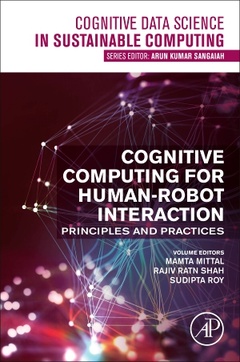Cognitive Computing for Human-Robot Interaction Principles and Practices Cognitive Data Science in Sustainable Computing Series
Coordonnateurs : Mittal Mamta, Shah Rajiv Ratn, Roy Sudipta

Cognitive Computing for Human-Robot Interaction: Principles and Practices explores the efforts that should ultimately enable society to take advantage of the often-heralded potential of robots to provide economical and sustainable computing applications.
This book discusses each of these applications, presents working implementations, and combines coherent and original deliberative architecture for human?robot interactions (HRI). Supported by experimental results, it shows how explicit knowledge management promises to be instrumental in building richer and more natural HRI, by pushing for pervasive, human-level semantics within the robot's deliberative system for sustainable computing applications.
This book will be of special interest to academics, postgraduate students, and researchers working in the area of artificial intelligence and machine learning.
Key features:
- Introduces several new contributions to the representation and management of humans in autonomous robotic systems;
- Explores the potential of cognitive computing, robots, and HRI to generate a deeper understanding and to provide a better contribution from robots to society;
- Engages with the potential repercussions of cognitive computing and HRI in the real world.
1. Introduction to cognitive computing and its various applications Sushila Palwe and Anita Gunjal 2. Recent trends towards cognitive science: from robots to humanized robots KatiyarSarthak and KatiyarKalpana 3. Cognitive compyuting in human activity recognition by healthcare robots S. Ravi Shankar, Gopi Battineni, and Mamta Mittal 4. Deep learning-based cognitive state prediction analysis using brain wave signals D. Devi, S. Sophia, and S.R. Boselin Pabhu 5. EEG-based cognitive performance evaluations for mental arithmetic tasks Debatri Chatterjee, Rahul Gavas, Roopkatha Samanta, and Sanjoy Kumar Saha 6. Trust or no trust in chat-bots: a millennial dilemma Shivani Agarwal 7. Cognitive computing in autonomous vehicles Atharva Sandeep Vidwans 8. Optimized navigation using deep learning techniques for automatic guided vehicles Anubha Parashar, Apoorva Parashar, and Lalit Mohan Goyal 9. Vehicular middleware and heuristic approaches for ITS systems of smart cities Rajender Kumar, Ravinder Khanna, and Surender Kumar 10. Error traceability and error prediction using machine learning techniques to improve the quality of vehicle modeling in computer-aided engineering A. Anny Leema, Krishna Sai Narayana, and Subramani Sellaman 11. All about human-robot interaction Kiran Jot Singh, Divneet Singh Kapoor, and Balwinder Singh Sohi 12. Teleportation of human body kinematicss for a tangible humanoid robot control Tutan Nama and Suman Deb 13. Recognition of trivial humanoid group events using clustering and higher order local auto-correlation techniques K. Seemanthini and S.S. Manjunath 14. Understanding the hand gesture command to visual attention model for mobile robot navigation: service robots in the domestic environment E.D.G. Sanjeewa, K.K.L. Herath, B.G.D.A. Madhusanka, H.D.N.S. Priyankara, and H.M.K.K.M.B. Herath 15. Mobile robots for air quality monitoring of landfill sites using the Internet of Things Rajesh Singh, Anita Gehlot, Shaik Vaseem Akram, Prabin Kumar Das, and Sushabhan Choudhury 16. Artificial intelligence and Internet of Things readiness: the inclination for hotels to support a sustainable envoronment Mudita Sinha, Leena N. Fukey, Ashutosh Sinha 17. Design and fabrication of a new multi-function smart trash bin based on the Internet of Things Bo Sun, Quanjin Ma, Hao Yao, Zidong Yang, Da Peng, and M.R.M.Rejab
Rajiv Ratn Shah currently works as an Assistant Professor in the Department of Computer Science and Engineering (joint appointment with the Department of Human-centered Design) at IIIT-Delhi. He is also the director of the MIDAS Lab at IIIT-Delhi. He received his Ph.D. in computer science from the National University of Singapore (NUS), Singapore. Before joining IIIT-Delhi, he worked as a Research Fellow in Living Analytics Research Center (LARC) at the Singapore Management University (SMU), Singapore. Prior to completing his Ph.D., he received his M.Tech. and M.C.A. degrees in Computer Applications from the Delhi Technological University (DTU), Delhi and Jawaharlal Nehru University (JNU), Delhi, respectively. He has also received his B.Sc. in Mathemat
- Introduces several new contributions to the representation and management of humans in an autonomous robotic system
- Explores cognitive computing, robots and HRI, presenting a more in-depth understanding to make robots better for society
- Gives a challenging approach to those several repercussions of cognitive computing and HRI in the actual global scenario
Date de parution : 08-2021
Ouvrage de 418 p.
15x22.8 cm
Thèmes de Cognitive Computing for Human-Robot Interaction :
Mots-clés :
3D point cloud; Activity recognition; Affect-based trust; Air quality; Arduino uno; Artifact; Artificial Intelligence; Artificial insight; Artificial intelligence; Back propagation; Brain activation; CAE; CAN; CNN; CNN classifier; Chatbots; Cognitive capabilities; Cognitive computing; Cognitive performance; Cognitive science; Cognitive-based trust; Completed local binary pattern; Computational technology; Computer vision; Contextual awareness; Convolutional neural networks; DWT; Data; Deep learning; Deep learning algorithm; Digital computer; ECNN; EEG; End-to-end; Error prediction; Error traceability; Fuzzy c-mean clustering; GAN; Garbage classification; Gesture classification; Gesture teleportation; HCI; HRI; Hand gesture recognition; Healthcare robots; High order local auto-correlation; Hotel management; Human; Human-chatbot interaction; Human-machine interaction; Human–robot collaboration; ITS; Internet of Things; Internet of things; IoT; Kinect camera; Kinetic movements; LGA descriptor; LIDAR; Landfilling sites; Leap motion controller; LoRa radio modem; Localization; MSW; Machine learning; Machine learning techniques; Mental arithmetic; Millennial; Mobile ad hoc networks; Mobile robot; NAO robot; Natural language processing; Neural network; Neural synaptic core; Neuromorphic architecture; PAN; RDS; RNN Classifier; ROS; Robot interaction; Robot navigation; Robots; SABRE; Segmentation; Skeleton movement; Smart car; Smart trash bin; Sustainability; Sustainability readiness; Trust; V2I; V2V; VANET; Visual attention; Visual-based SLAM; WSN



